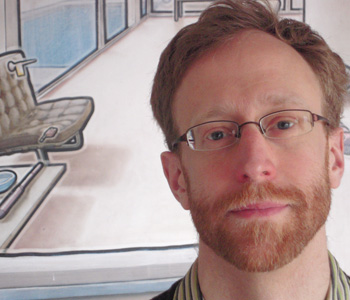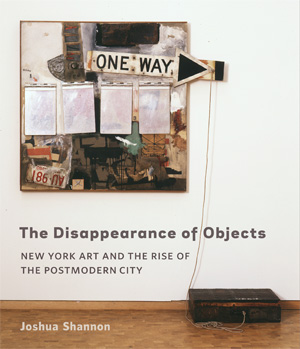
New York’s artists around 1960 were living in the shadows of the city’s deindustrialization—moving among demolition sites, abandoned factories, and decrepit hardware stores, while all around them new highways, sleek skyscrapers, and urban renewal projects were forever altering the city’s purpose and shape. The purpose of The Disappearance of Objects is to tell this important chapter of postwar art history, but especially to place that strange history back in the context of a city undergoing incredibly rapid change.
Using four case studies focused on the work of Jasper Johns, Donald Judd, Claes Oldenburg, and Robert Rauschenberg, the book discusses the art of this period as a deeply revealing (if also clumsy) effort to understand New York’s first stages of postmodernization. Oldenburg installed room-sized works made from trash, Johns sculpted heavy little replicas of outmoded flashlights and beer cans, Rauschenberg made paintings out of nineteenth-century architectural scraps, and Judd ordered up crystalline sheet-metal boxes. In various ways, all this difficult-to-interpret art offered an unusually sophisticated way of thinking about the changing texture of everyday life.
The book’s title comes from a note in Johns’s sketchbook about the “loss, destruction, disappearance of objects.” I hope that the book communicates what this art taught me about how recent history has brought an abstraction of our everyday spaces, a shift toward systematicity and away from particular, palpable things. Of course I hope, too, that the book serves as a way for us to think historically and critically about the texture of life in the present, about how profoundly our relationship to the material world has changed in a few short decades.
“The purpose of The Disappearance of Objects is to tell this important chapter of postwar art history, but especially to place that strange history back in the context of a city undergoing incredibly rapid change.”
I came to this topic as an art historian, trying to make sense of some art I really liked but couldn’t understand or explain. As I looked at the art more and more, and as I began sorting through archives, I discovered that these sculptures and paintings and installations had deep relationships to a chaotic time in a very chaotic city.
Johns and Rauschenberg were literally moving from loft to abandoned industrial loft as their homes were demolished to make way for new skyscrapers. Oldenburg installed a work called The Street just around the corner from a massively contentious effort (which eventually failed) to plow an expressway through Washington Square Park. I became fascinated with the urban history, and found its unfolding evidence in the Village Voice and in old fire-insurance maps. Eventually the project turned into a book as interested in New York as it is in understanding the art.
Soon the art made more sense to me (or I felt more comprehending of its nonsense), and I drew connections between the obstructions in the art and all the new blockages and clearings in the city. If the book straddles the realms of art history and urban history, though, I also mean it to be an entry in the theorization of contemporary experience. I want the book to contribute to our understanding of how our daily lives are constantly reshaped by the history of capitalism.
I think most of my readers so far have been people interested in postwar art. But the book is written for anyone interested in the cultural history of the last several decades, and for anyone who just loves the history of New York.
Probably the part of the book I like best is the chapter on Donald Judd’s Minimalist sculptures; if someone were to casually flip through and land on a section to read, I’d want it to be the end of this last chapter and then the book’s short conclusion.
Judd’s art has lately been understood primarily as a resistance to depiction: his simple metal boxes don’t represent anything, they insist instead on simply being there. This interpretation is based on Judd’s own remarks, and I think it is right. What I found in my research, though, is that Judd and his early critics (and this seems to be a contradiction) also thought about his work in relationship to architecture, shipping, computers, and so on. I became really interested in trying to think both of these things at once: Judd’s work is totally independent of reference and, at the same time, deeply influenced by the contemporary landscape. “I don’t much like the idea of representing the United States in my work,” Judd once told an interviewer in the sixties, “It’s just that you live here and you are involved in your sense of what’s around you.”
I became especially interested in an ambivalence or dialectic in Judd’s work (perhaps easiest to see in the works before his Minimalist boxes) between an aesthetic of abstraction, modularity, and systematicity, on the one hand, and a traditional, sometimes even gummy aesthetic of palpable materiality, on the other. This fact helped me to see that a similar dialectic was then at work in New York, too—even on the section of Fourth Avenue beneath Judd’s windows: the city was caught between a new fantasy of the frictionless, globally interconnected provision of services and an old industrial landscape of manual labor and quirky architecture.
As he moved on to making his sculptures by ordering metal boxes from a sheet-metal shop, Judd said he wanted the works to be hand-made, but to look as if they had been “stamped-out.” He was ambivalent about whether to refer to his fabricators, Bernstein Brothers Sheet Metal Specialties, with the antiquated term “tinsmiths,” or instead to call them, somewhat grandiosely, a “factory.”
What I seek to do at the end of the chapter is to connect these tensions in the city’s character to the vocabulary that animated art criticism throughout the postwar decades. I think I have discovered that terms and problems that seemed purely to belong to the realm of the art discourse were in fact so bitterly contested precisely because they were also ways of thinking about the changing texture of New York, even of contemporary life. For a fuller explanation, you’ll have to read the book!
“Judd’s work is totally independent of reference and, at the same time, deeply influenced by the contemporary landscape.”
I would be pleased if The Disappearance of Objects could make a few different kinds of contributions.
On one level, of course, I simply hope to give readers a means to complicate and enrich their encounters with the art works discussed. I hope, too, that the book will change the way we think about art in the postwar decades, by helping us to understand that the problems and ideas of late modernist art were deeply intertwined with the changing quality of everyday life. By extension I hope that this book can serve as an example for a new kind contemporary art history—one that combines the theoretical interests that usually dominate the field with the weight and flavor of historical specificity.
Above all, I think we need to be able to think really closely about art while thinking equally closely about history. I would be especially gratified if historians took up the book as an account of the ways in which our experiences of ordinary space have changed with the rise of the postmodern economy.


Joshua Shannon is Assistant Professor of contemporary art history and theory at the University of Maryland. In 2009-10, he holds the Terra Visiting Professorship of American Art at the Freie Universität Berlin, where he is working on a new book called The Recording Machine: Photography and Realism since the 1960s.